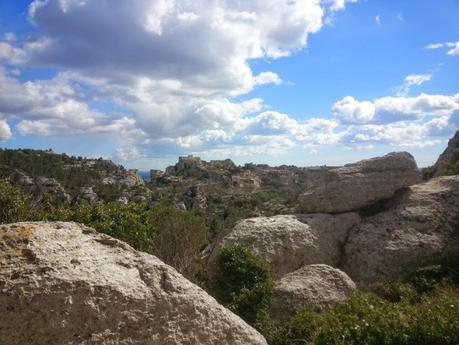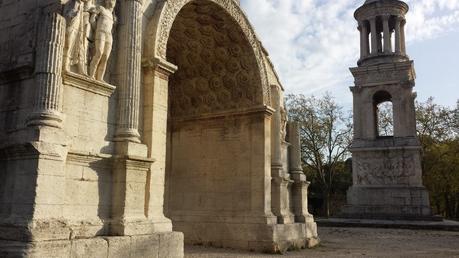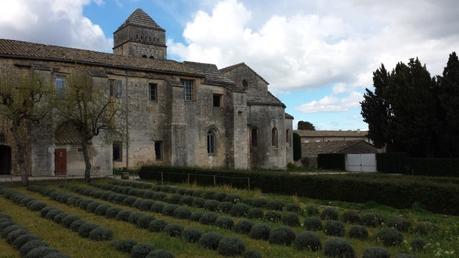Guest Wine Writer Series:
Jill Barth
The Wines of Baux de Provence
Jill Barth and I have worked together before, in this DuVine story showcasing the annual Hospices de Beaune Wine Auction in Burgundy.
Here, I invite Jill to share her extensive Provence prowess.
[Reprint from a previous guest writer series.]
“Artfully Crafted: The Wines of Baux de Provence”
by Jill Barth
 A view of the village of Les Baux de Provence, carved into the Alpilles Mountains. Credit: Jill Barth
A view of the village of Les Baux de Provence, carved into the Alpilles Mountains. Credit: Jill Barth
Some things never get old: a late-sleep on the weekend, a hug from my kids, the scent of cinnamon apple, and wine from southern France…
Southern Rhône and Provençal wines truly inspire me, as they’ve done since I wrote my first paragraph about wine. While some of the wines from the area have their own zip code in cellars and wine shops, others are hidden behind importing limitations, small production or other roadblocks to global distribution. There are treasures to be discovered, and surprises of excellent taste and value.
One of these sweet spots is Baux de Provence AOP, in the northwestern corner of the Bouches du Rhône département. The vineyards cradle the Alpilles Mountains, a sort of inverse nest covered by scrub woods of rugged, herbal antiquity which embody the sight, scent, feel and taste of Provence. Situated around these mountains are a pocketful of communes, small hamlets of village and farm life. Eight villages and 12 estates form the collection of winemakers of Baux de Provence AOP (Appellation d’origine controlee).
Biodynamics in Practice
Established on paper as a proper AOP 23 years ago, this is the sort of place that was established in practice well before the paperwork caught up to it. This is quite common in France; in fact, this is the working model of the system: walk the talk, do the work, make the wine and then ask about the label. The vignerons of Baux-de-Provence are still waiting on the paperwork to catch up in a very distinct way. Nearly 85% of the AOP practices biodynamique farming and viticulture. In France (and in other places) there is a process to become biodynamically certified and in fact many producers have undergone the steps to proudly announce their commitment. However, the AOP as a whole has not achieved a formal biodynamic status, but some are working towards this end…if it makes sense…and in fact, natural methods are often practical in vineyards that benefit from the cleansing puff of the Mistral wind that is present in the vineyards of Baux de Provence. Also, many of the producers here employ ancient ways, some of which have never departed from biodynamic procedures since their original days of growing crops for sustenance.

Making Wine in Baux de Provence
The sense that the vignerons care deeply about the environment is apparent. And why wouldn’t they be? This space is something incredible. Baux de Provence is one of the few areas in Provence where red wines are predominant.Red wine production accounts for about 60%, rosé about 35%, and white wine (since their inclusion in AOP in 2011) a slight 5% or less of production.
Grenache, Cinsault, and Syrah are the primary grapes used to make red and rosé wines, which must include a minimum of two grapes, and Grenache, Cinsault, and Syrah must account for at least 50% of the blend. Other common blending grapes for red and rosé wines include Carignan, Cinsault, Counoise, Mourvèdre, and Cabernet Sauvignon. White wines composition is required to be 60% combined Clairette, Grenache Blanc, and Rolle (Vermentino), 10-30% Roussanne; Bourboulenc, Marsanne, and Ugni Blanc.
The vignerons of Baux de Provence are Chateau Dalmeran, Chateau Romanin, Chateau d’Estoublon, Domaine De Lauzières, Domaine Guilbert, Domaine de la Vallongue, Domaine des Terres Blanches, Domaine Hauvette, L’Affectif, Mas de la Dame, Mas de Gourgonnier, and Mas Sainte Berthe. Domaine de Trévallon opts to make IGP wines, rather than comply with the restrictions of making AOP wines.

A Treasure Chest
The area is also a designated origin for olives and olive oil, and it is not uncommon for both vineyards and olive groves to be tended by local domaines. The olive essence, to me, is imparted into the flavor of the wines, particularly the Syrah. This makes for a lovely unique profile, one that brings me back to Provence each time I open a bottle.
The area sits on an ancient Roman route and settlement, and Roman artifacts and structures still exist. Outside of St. Rémy-de-Provence a preserved space known as Les Antiques is the site of ancient Roman and Greek assemblies. The famous plane trees that line the rural roadways and village streets are of Roman origin as are some of the aqueducts that carry water through the area.
The area fosters a strong history of art and literature, a common inspiration being the light and shade that is famously stunning in Provence. Vincent Van Gogh spent some of the last months of his life within sight of Les Antiques and the village of St. Rémy-de-Provence when he was housed in Saint Paul de Mausole. It was here that he was cared for during unstable mental times and during his stay he painted the landscape, including The Starry Night, in which the village of St. Rémy is depicted. “This morning I saw the countryside from my window a long time before sunrise, with nothing but the morning star, which looked very big.” Van Gogh said of his inspiration for this piece.

This area continues to inspire the winemakers of Baux de Provence, as they steady themselves with the quality of the terroir, tradition and Provençal creativity. People from all over the world visit Provence, to seek sun and sand, and while they are there it is often rosé in their glasses. The best rosés in the world come from Provence, and they can open the path the delights of the nearly-secret red wines of Provence and the even more exclusive wines of Baux de Provence, a space with remarkable heritage.

About the Author:
Jill Barth is a Provence Wine Master through the Wine Scholar Guild and received a fellowship to the Symposium for Professional Wine Writers. She’s the founder and author of L’Occasion, a blog that been awarded the Best Overall and Best Writing from the prestigious Wine Media Awards and was a finalist for Millesima’s Blog Awards in food and wine pairing. Jill is an Born Digital award-nominated Forbes columnist and wine country travel expert panelist and contributor for USA TODAY’s 10Best. Her work has appeared in Wine Enthusiast, Decanter, Relais & Châteaux Instants Magazine, Palate Press, Luxe Provence, VinePair, Courrier International, Provence WineZine, and Perfectly Provence.
Story and images printed by permission of the author, Jill Barth.
More Guest Writers:
Caroline Henry: “Bioenergetics Wines in Champagne.”
Copyrighted 2016-2019 LM Archer LLC. All Rights Reserved.

